Robin Brewster*, Cheryl Oetjen, Jumoom Ahmed, Sana Amjad, Adanech Debeli and Diana Portillo
School of Nursing, George Mason University, USA
*Corresponding Author:
Robin Brewster
Assistant Professor
School of Nursing
George Mason University, USA
Tel: 703-993-2974
E-mail: rbrewste@gmu.edu
Received Date: March 31, 2017; Accepted Date: May 02, 2017; Published Date: May 11, 2017
Citation: Brewster R, Oetjen C, Ahmed J, et al. Student Excel! Program: Applying Structure and Vision to Clinical Learning Excellence. J Healthc Commun. 2017, 2:3. doi: 10.4172/2472-1654.100065
Keywords
Communication; Clinical; Informatics; Nursing
Introduction
Every academic program struggles to balance frequently conflicting program requirements, not the least of which are those levied by the accrediting agency. George Mason University is no exception. The Mason School of Nursing programs provide preparation for the future nurse, nurse practitioner, nurse educator, and nurse administrator workforces [1]. Each of these programs is bound to attainment of role-specific essentials of education and skills competencies. The American Association of Colleges of Nursing [2] developed essentials for each level of nursing education-bachelors, masters, and doctoral- that serve as the foundational work of curriculum development, evaluation, and accreditation. Advancement of students toward the essentials and competencies is required to ensure both the quality of education and maintenance of accreditation standards, including tracking hours at clinical sites, skills practiced, and experiences encountered. Throughout the program, the status of the students’ progression against these requirements must be accurately and effectively communicated between students, faculty, preceptors and evaluators in a timely fashion to identify problems and gaps as early as possible and gauge progression.
Mason has tried a variety of commercial tools to support these communication needs. Unfortunately, these tools were inflexible for the students, cumbersome for the faculty, and did not easily support outcomes analysis for program evaluation and accreditation. As a result, information was collected in a much decentralized manner and communication between the affected parties was frequently incomplete, untimely, and chaotic (Figure 1).
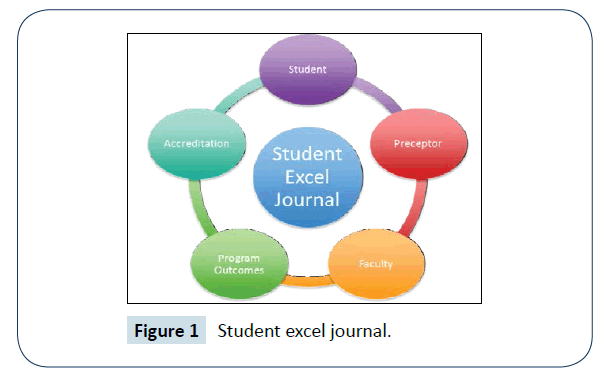
Figure 1: Student excel journal.
Mason faculty has a different vision to track these requirements and ensure effective and accurate communication between the involved parties. That vision included centralized data collection and threading of specific “themes”, professional writing and use of technology, throughout the programs. The “Students Excel!” program was designed to support that vision. At the center of this program is the journal, the centralized collection point for student data and the source for automated communication between students, faculty and preceptors (Figure 2).
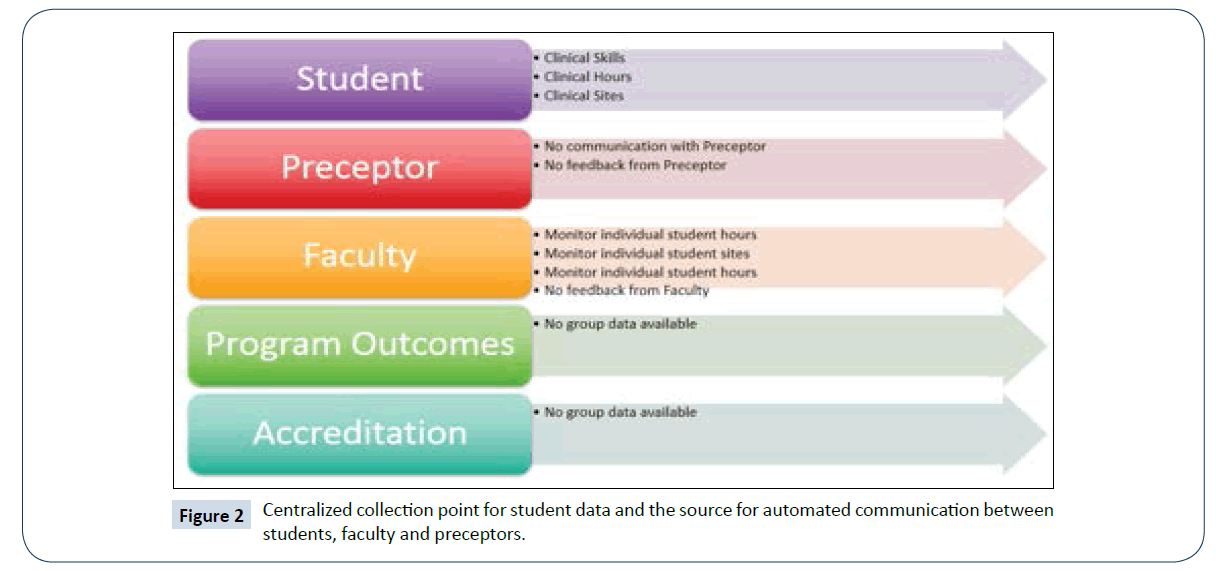
Figure 2: Centralized collection point for student data and the source for automated communication between students, faculty and preceptors.
The journal is designed to collect all data associated with the students’ progression through their program, including clinical hours, clinical site and preceptor data, tracking of skills, and experiences. Skills are tracked to the “observed”, “assisted” and “performed” level, while essentials/competencies are tracked to the “exposure”, “immersion” and “competency” level. The journal is based on Excel, which provides not only the capability required for the tracking, but also supports the Mason goal of technology use, one of the fundamental themes threaded throughout the Mason graduate nursing programs. Faculty attempt to embed the use of technology wherever possible as a part of every course with the intent to increase exposure to, skills development of, and comfort level with tools that can be used to advance knowledge and increase productivity. That especially runs true with database tools. While most students are somewhat familiar with Excel, very few are familiar with the very powerful use of forms, formulas and macros built into these Microsoft products. The journal uses all three, each of which must be utilized by the students to enter data and generate the graphics.
The following figures (Figures 3-10) provide examples of the main journal worksheets and the graphs generated from the journal data. These graphs facilitate rapid communication of progression toward the program requirements.
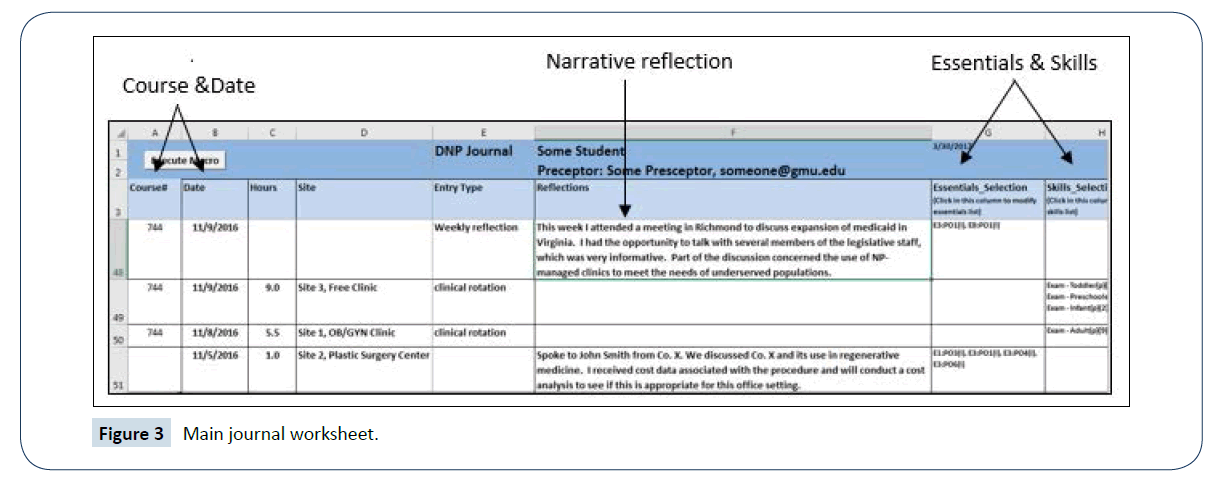
Figure 3: Main journal worksheet.
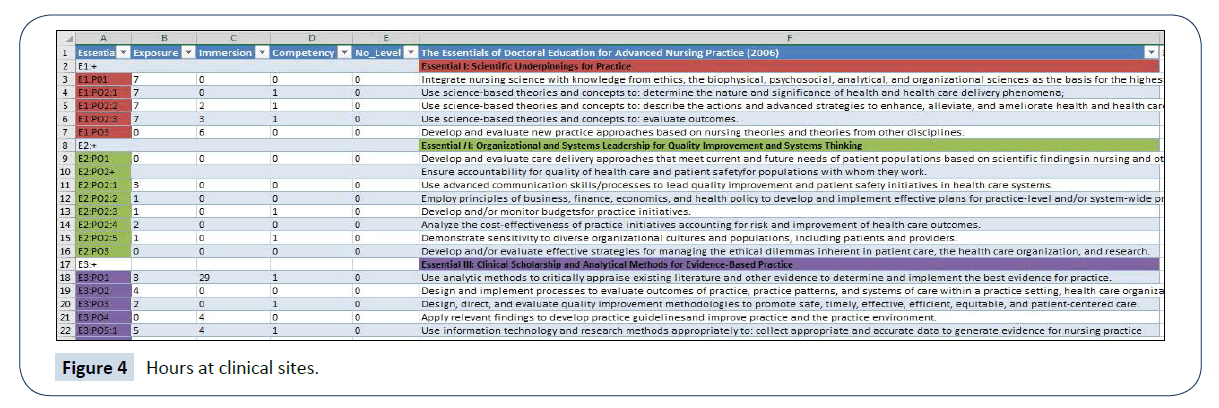
Figure 4: Hours at clinical sites.
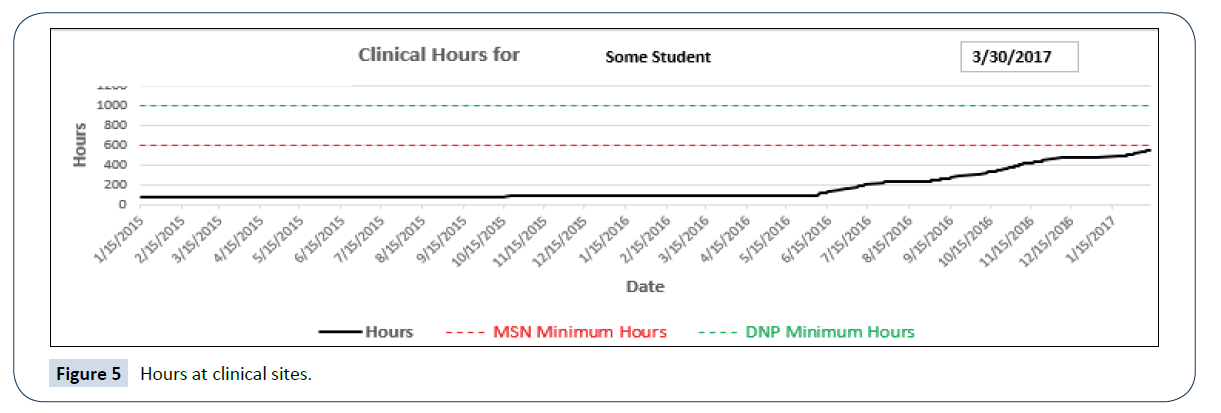
Figure 5: Hours at clinical sites.
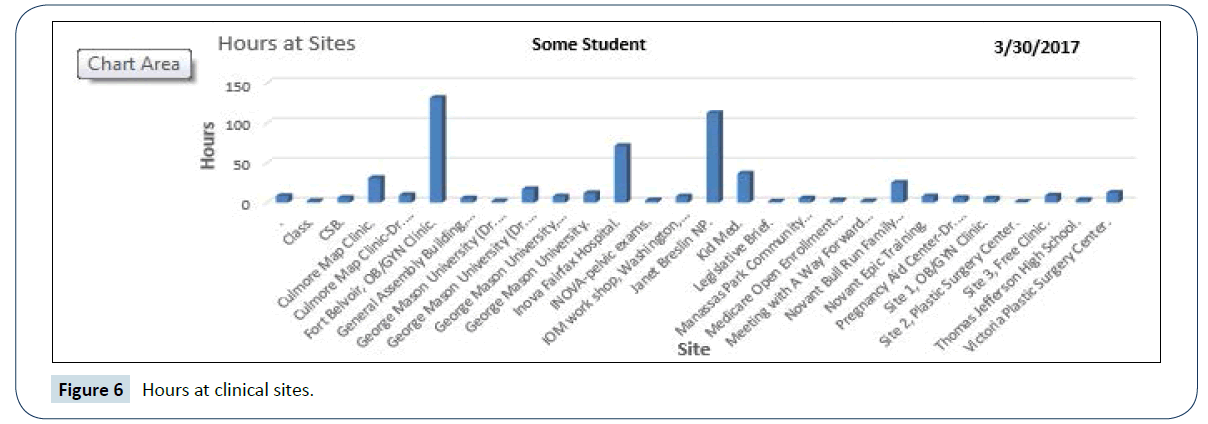
Figure 6: Hours at clinical sites.
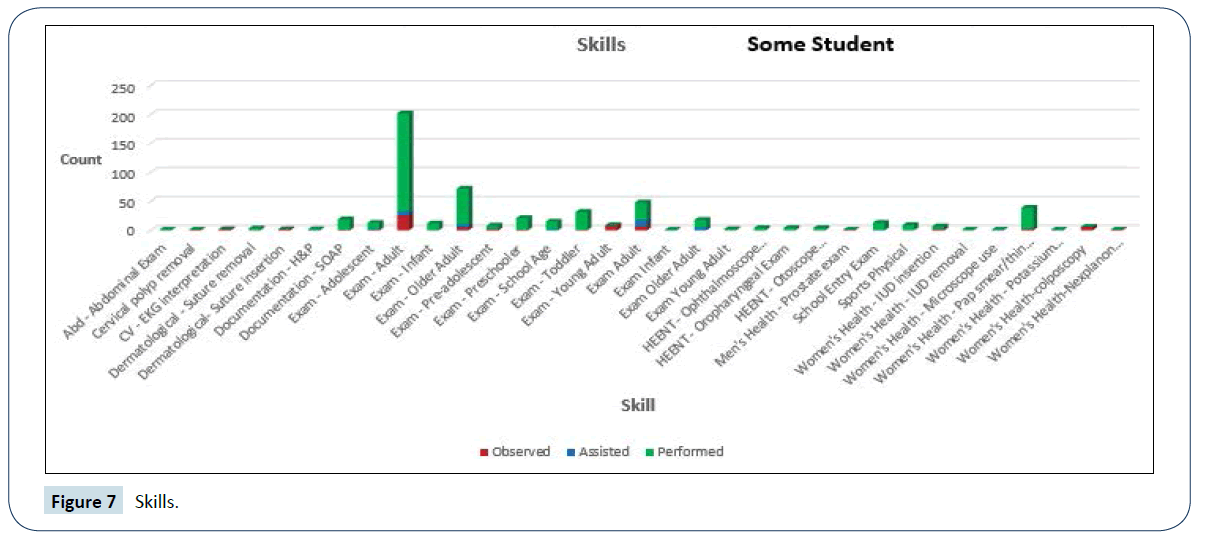
Figure 7: Skills.

Figure 8: Essentials/Competencies.

Figure 9: 3-D essentials/Competencies over time.

Figure 10: HIT core competencies.
The “Students Excel!” program originated with the Mason nurse practitioner programs; however, it quickly became evident that–with an adjustment to the essentials/competencies of education–the journal could be customized to other programs. Interprofessional practice is the hallmark of the Mason and Partners (MAP) clinic [3], where Mason students work together to provide care to uninsured patients. The clinic has connected the disciplines of nursing, psychology, social work and nutrition to provide interprofessional education and health care [4] and has now expanded to include the Healthcare Informatics Technology (HIT) Program under the Health Administration and Policy (HAP) department at Mason [5]. The Interprofessional Practice Educational Competencies (IPEC, 2016) serve as a guide in the clinic to drive interprofessional practice and education. Undergraduate students in HIT and HAP can do an internship with the MAP clinics [6]. The clinics provide exposure to the full range of HIT experiences and skills that are essential to meet competencies, from equipment management to grant reporting [7,8]. The undergraduate HIT internship is shaped around the American Health Information Management Association (AHIMA) “Health Information Management and Informatics Core Competencies for Individuals Working with Electronic Health Records” [9]. The HIT interns use the “Students Excel!” journal with the essentials tracking against those core competencies (Figure 8).
Feedback from Students Has Been Very Positive, as Demonstrated in the Comments Below
“Since implementation of this journal nearly one year ago, it has made clinical skill and DNP essential documentation exponentially easier. The traditional method of tracking patient encounters using the prior commercial system was laborious due to the time investment required to log each individual patient or experience; the GMU Excel Journal streamlines this process [10]. From the student perspective, it is convenient to have macros populate and tabulate skills and essentials as we gain progress through exposure, immersion, and competence. The program/graphs tab is appreciated because it displays progress towards meeting one's requirements for graduation on a daily, weekly, monthly, or semester basis. The graphs tab also displays, in a visually pleasing format, our progress towards achieving competence in the DNP essentials [11] which helps us to identify areas that require more attention or areas where we have invested our effort. It is hard to imagine tracking our progress without the functionality of the Journal.” BSN to DNP Student, spring 2016 “The journal provided to track our progress during our internship semester has been very valuable to me. It consists of a detailed list of competencies and skills set that Health Informatics students should be familiar with, before going out in the real world. The journal helps me observe, analyze and measure my performance and skills.
The competencies are categorized by the level of expertise and these aids in providing a roadmap for evaluating and tracking which area I need to focus on and build my skill set to succeed in this field. Once we enter the data into the specific fields, graphs are automatically created, displaying data and trends, showing our development in each competency. The graphs will be beneficial during our interviews; we can have a portfolio with our resumes and the journal attached so that the interviewer can visually see our progress and the work we performed.” Health Informatics Intern, Spring 2016 “As an undergraduate student in my last semester, there is a lot of pressure to attain a job. Fortunately, with the Excel journal, I can track my skills, hours, and essentials of informatics EHR core competencies throughout my internship. This journal helps me keep track of my accomplishments and allows me to reflect on the experiences I have had. I have become more self-aware by recording my experiences and tracking my progress. Visually, this journal can convey my growth throughout this internship through graphs and charts. Not only does this journal benefit me, but it helps communicate my accomplishments to my preceptor. By keeping track of occurrences in my journal, learning, and insights, I have a reminder on crucial details and reflect on my experience as an intern to my preceptor. As an undergraduate student interviewing with a potential employer, it important for me to be self-aware of where I am now and my goals and aspirations for the future. This visual communication tool can also be used when interviewing with potential employers. It is extremely easy to forget crucial details throughout the internship, especially during an interview. Fortunately, I can use this journal to keep track of these details to provide examples and experiences in an interview. Being able to go into an interview and share my accomplishments, along with visual examples and documentation for validation will help improve communication between the potential employer and myself. Learning how to clearly communicate verbally is essential, but communicating visually by using a journal exceeds expectations.” Health Informatics Intern, Spring 2016 “The journal is the best form of a progress report. The idea to keep a chart of what you are doing, how many times you are doing it, and your thoughts about what you are doing allows the viewer to take a glance of your overall performance. To have a journal that tracks how many times you did certain skills will become useful to prove how you have mastered it. The journal goes in-depth by having different pages that will focus on a feature of your overall experience and create what will essentially be a visualize aid such as a graph. This will help keep me as a health informatics intern to showcase what I have learned throughout this internship and intrigue potential hiring manager for my future career.” Health Informatics Intern, Spring 2016 “The most important component of the journal is the graphs, especially showing the levels of the essentials/competencies. With the different levels, I can see my growth toward achieving competency in the essentials. This is very important especially to future employers. I will be able to show them what I have learned and my level of competency for each skill and essential. I do not know where this journal has been in the past. I wish I had it when I started college so I can have data at the end that I can add to my portfolio.” Health Informatics Intern, spring 2016 Implementation of the “Student Excel!” journal has provided a single collection point for student reflection, hours, skills, and competency attainment related to clinical and internship rotations. The graphs provide a visualization of the information in a manner that facilitates communication and understanding of the clinical experience. The format has proven to be highly adaptable across disciplines while providing a consistent format foundation.
References
- College of Health and Human Services (CHHS) (2017) School of nursing.
- (2017) American Association of Colleges of Nursing.
- https://www.fairfaxcounty.gov/HSRG/pages/ServiceProfile.aspx?orgrsn=3087&svcrsn=12764&locrsn=8565&Svcname=FREE+MEDICAL+CLINIC&orgname=MASON%20AND%20PARTNERS%20FREE%20CLINICS%20-%20GEORGE%20MASON%20SCHOOL%20OF%20NURSING
- Sutter-Barrett R, Sutter-Dalrymple C, Dickman K (2015) Bridge care nurse-managed clinics fill the gap in health care. J Nurse Pract 11: 262-265.
- Brewster R, Scully C, Saeed A, Chhetri S, Irigoyen L (2016) Sharing the educational wealth: A nursing and health informatics program collaboration. J Health Care Poor Underserved 27.
- Department of Health Administration and Policy (HAP) (2017) Health Informatics at Mason.
- Palkie B (2013) The Perceived Knowledge of Health Informatics Competencies by Health Information Management Professionals. Educational Perspectives in Health Informatics and Information Management pp: 1-11.
- HealthIT.gov (2017) What skills does our team need to implement and support an electronic health record system?
- American Medical Informatics Association (AMIA), Joint Work Force Task Force (2008) Health information management and informatics core competencies for individuals working with electronic health records.
- Jelen B, Syrstad T (2010) Unleash the power of Excel with VBA. VBA and Macros, Microsoft Excel 2010.
- American Association of Colleges of Nursing (2006) The essentials of doctoral education for advanced nursing practice.











